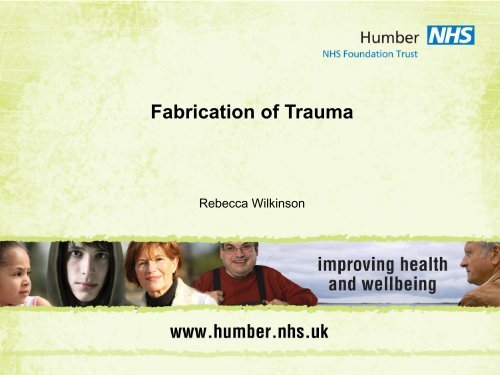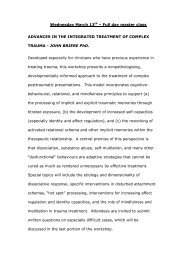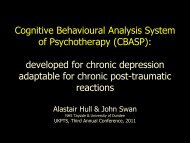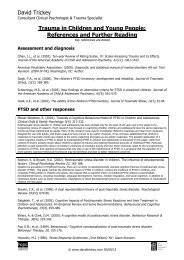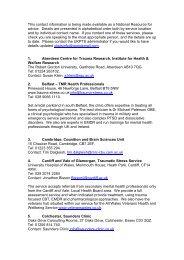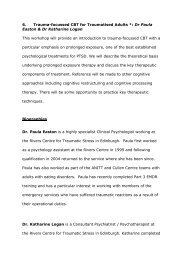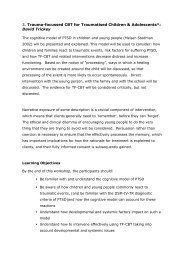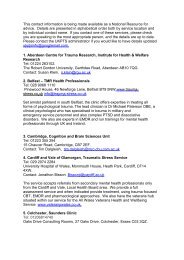Fabrication of Trauma - ukpts
Fabrication of Trauma - ukpts
Fabrication of Trauma - ukpts
Create successful ePaper yourself
Turn your PDF publications into a flip-book with our unique Google optimized e-Paper software.
<strong>Fabrication</strong> <strong>of</strong> <strong>Trauma</strong><br />
Rebecca Wilkinson
Workshop aims<br />
to increase awareness on identification <strong>of</strong> fabrication within the ex -<br />
service population and to facilitate reflection<br />
and discussion on the possible reasons people fabricate and underlying<br />
personality processes.
Outline<br />
Brief overview <strong>of</strong> the service I work in and how I came across the issue<br />
<strong>of</strong> fabrication<br />
How prevalent is the issue<br />
How is fabrication defined<br />
How can you identify it within the ex military/ military population.<br />
Memory and PTSD<br />
The 7 sins <strong>of</strong> memory
Personality Disorder<br />
How we assess for PD<br />
Its relevance to fabrication<br />
The different types <strong>of</strong> PD<br />
Relate to Case study examples<br />
How do you then address this as part <strong>of</strong> client assessments and<br />
interventions? What might you begin to think about?<br />
Feedback and main group discussion<br />
Questions and close
<strong>Fabrication</strong>
Humber <strong>Trauma</strong>tic Stress Service<br />
PTSD Service piloted 1996-98<br />
Provide specialist assessment, formulation and intervention for ex-military<br />
personnel affected by exposure to trauma<br />
Psychological intervention, Occupational Therapy, Dual Diagnosis work<br />
Nurse with experience working for the MOD.<br />
links with national and local military.<br />
Work alongside other agencies<br />
Service expanded in 2009 in Hull
Who do we see?<br />
Mainly Complex (multiple or prolonged) type II trauma<br />
On occasions Type I trauma when accompanied with others<br />
factors e.g. self harm, previous treatment ineffective<br />
Comorbidity – alcohol and substance misuse, anxiety and<br />
depression, obsessive traits, personality traits<br />
Mainly army, majority male, late 20’s early 30’s<br />
NI, Falklands, Bosnia, Kosovo, Iraq, Afghanistan
Service Model<br />
Referrer<br />
Military Records<br />
Assessment<br />
Team<br />
discussion<br />
Family/ Partner<br />
Dual diagnosis<br />
Stabilisation Processing Integration
Veterans Outreach Pilot Project<br />
Recognition that group <strong>of</strong> veterans not being reached<br />
PTSD not most common mental health problem in veterans<br />
Evidence shows veterans generally happy with NHS services<br />
once accessed them, problem is getting into services<br />
Potential need to develop different approach to engaging<br />
veterans in mental health services<br />
Pilot to scope need and trial different routes <strong>of</strong> access
Structure and Staffing<br />
Humber Host Trust<br />
Administrator Band 3<br />
0.8wte<br />
Hull, ER,N Lincs,<br />
York and<br />
North Yorkshire<br />
Leeds, Bradford,<br />
Wakefield<br />
Sheffield, Barnsley,<br />
Doncaster, Rotherham<br />
Veterans Outreach<br />
Post Band 7<br />
Veterans Outreach<br />
Post Band 7<br />
Veterans Outreach<br />
Post Band 7<br />
Humber NHS<br />
Foundation Trust<br />
Leeds Partnerships<br />
NHS Foundation Trust<br />
Sheffield Health and<br />
SC Foundation Trust
Outreach pilot further Highlighted fabrication and its co morbidity with<br />
disorders <strong>of</strong> the self and addictions<br />
Of 31 cases seen within the outreach service pilot 17 were fabricating<br />
their military history<br />
Of those who fabricated in this population all had served, but less than<br />
the time they stated for example 3 only completed basic training but<br />
reported they had been on operational deployment, many <strong>of</strong> the cases<br />
reported they had been to on ‘black (secret) ops’; reported they were<br />
members <strong>of</strong> SAS or Parachute Regiment or had been on operational<br />
tour when they had not..
6 pilot projects: Stafford, Camden & Islington, Cardiff, Tyne Esk & Wear, St<br />
Austell, Lothian. Most have estimated 50%-70% embellished or fabricated in<br />
some way.<br />
Why Fabricate ?<br />
Do Veterans think they need to have PTSD to access treatment?<br />
Or is it a badge <strong>of</strong> honour?<br />
Or is It something else ?<br />
In general the fabrication for the outreach cases was an exaggeration and<br />
embellishment <strong>of</strong> the truth in many cases it appeared to be a way to feel they<br />
had achieved something, in others it became a reason for not achieving<br />
significantly where they had sought to find a family in the army structure that<br />
had been lacking previously the army appeared to become the scapegoat and<br />
cause <strong>of</strong> everything wrong in their life.
“It is rare to find a psychiatric diagnosis that<br />
anyone wants to have, but PTSD seems to be one <strong>of</strong> them”<br />
(Andreasen, 1995, p. 963).
“Some individuals who never even served in military combat<br />
have successfully acquired service-connected benefits for<br />
PTSD (Burkett & Whitely, 1998). A valuable procedure to<br />
support or refute an account <strong>of</strong> combat experiences is the<br />
collection <strong>of</strong> collateral data.”
“Those malingering PTSD may state that their records do not reflect their<br />
covert missions or ‘black ops’; hence no evidence <strong>of</strong> their experiences<br />
exists. If there is no written record <strong>of</strong> one <strong>of</strong> these events, look for the<br />
special training required for these missions. The terms Selection,<br />
specialist courses passed, classified training/mission will appear with<br />
dates (Burkett & Whitely, 1998). “
“Although fabricated stories that are as vivid and horrifying as the experiences <strong>of</strong> true<br />
combat veterans (Burkett & Whitely, 1998; Hamilton, 1985) they may reveal their<br />
fabrication by incorrectly identifying certain details, including geography and culture <strong>of</strong><br />
the area, military terminology used at the time and dates related to specific events”<br />
(Burkett & Whitely, 1998)
Genuine PTSD<br />
Minimise relationship <strong>of</strong> symptoms to<br />
combat<br />
Blame themselves<br />
Dream themes <strong>of</strong> helplessness<br />
Deny emotional impact <strong>of</strong> combat<br />
Are reluctant to tell combat memories<br />
Have survivor guilt related to specific incidents<br />
Avoid environments that resemble combat<br />
Show anger at helplessness<br />
Malingered PTSD<br />
Emphasize relationship <strong>of</strong> symptoms to combat<br />
Blame others<br />
Dream themes <strong>of</strong> grandiosity or power<br />
“Act out” alleged feelings<br />
“Relish telling combat memories<br />
Have generalized guilt over surviving the war<br />
Do not avoid environments that resemble combat<br />
Show anger at authority
Case Study<br />
Client referred by GP showing symptoms <strong>of</strong> PTSD, Client<br />
reports that he was a Chef in the RLC. He reports to have<br />
witnessed been exposed to various contacts with the Taliban<br />
when he was selected to go out on operations with special<br />
forces.
Investigations <strong>of</strong> records and Confidential reports show that<br />
this client is telling the truth – born in the UK with heritage from<br />
Pakistan he was fluent in Pashto and Dari (amongst other<br />
languages) and he was able to act as an interpreter when<br />
operational circumstances meant normal channels broke<br />
down, he was reliable and given positive reports for his<br />
adaptability.<br />
Be Aware sometimes it may not sound real but is true<br />
and other times it sounds very real but is fabricated!
Memory
Memory<br />
The 7 sins (D.Schacter<br />
2001)<br />
There are genuine mistakes in memory recollection. It is worth<br />
considering these possibilities in our assessment <strong>of</strong> authenticity or<br />
fabrication
Omission: (Involves forgetting)<br />
the result is a failure to recall an idea, fact, or<br />
event<br />
1. Transcience - the general deterioration <strong>of</strong> a specific memory over time.<br />
2. Absent mindedness - memory breakdown involves problems at the point<br />
where attention and memory interface<br />
3. Blocking - when the brain tries to retrieve or encode information, but<br />
another memory interferes with it
Commission:<br />
(Distorted or unwanted<br />
recollections) there is a form <strong>of</strong> memory<br />
present, but it is the desired fact, event, or ideas<br />
4. Misattribution<br />
Misattribution entails correct recollection <strong>of</strong> information with incorrect recollection<br />
<strong>of</strong> the source <strong>of</strong> that information.<br />
Example: A soldier who witnessed a shooting just after attending a training<br />
course may blame the shooting on someone who was at the training course.
5. Suggestibility<br />
Memories <strong>of</strong> the past are <strong>of</strong>ten influenced by the manner in which they are<br />
recalled, and when subtle emphasis is placed on certain aspects <strong>of</strong> the event<br />
those emphasized aspects are sometimes incorporated into the recollection,<br />
whether or not they actually occurred.<br />
Example: A sergeant witnesses three hostages being kidnapped, a woman and<br />
two men. He later reads in the newspaper that two women and one man were<br />
kidnapped and he remembers it as two women and one man.
6. Bias<br />
One's current feelings and worldview distort remembrance <strong>of</strong> past events. This<br />
can pertain to specific incidences and the general conception one has <strong>of</strong> a<br />
certain period in one's life.<br />
This occurs partly because memories encoded while a person was feeling a<br />
certain level <strong>of</strong> arousal and a certain type <strong>of</strong> emotion, come to mind more<br />
quickly when a person is in a similar mood.<br />
Example: An ex-army <strong>of</strong>ficer, retired from the service is getting married and<br />
really enjoying the experience. He get’s into conversation with some members<br />
<strong>of</strong> his squadron at the wedding and talks about his experiences in Iraq with<br />
enjoyment and pleasure. This is not representative <strong>of</strong> the actual experience in<br />
which he witnessed a great deal <strong>of</strong> death and destruction. His colleagues who<br />
are not in the same present state <strong>of</strong> mind may feel confused at his response.
7. Persistence<br />
(A thought you can’t get rid <strong>of</strong>)<br />
This failure <strong>of</strong> the memory system involves the unwanted recall <strong>of</strong><br />
information that is disturbing. The remembrance can range from a blunder<br />
on the job to a truly traumatic experience, and the persistent recall can<br />
lead to formation <strong>of</strong> phobias, post-traumatic stress disorder, and even<br />
suicide in especially disturbing and intrusive instances. (The body<br />
remembers)<br />
For example: The body physically reacts to a loud bang in the present in<br />
the same way it would have been on alert to explosions etc in the war<br />
zone.
In summary - The significance <strong>of</strong> memory<br />
Memory can be commissioned out <strong>of</strong> the clients awareness. It may<br />
serve a purpose for the client but has not been intentionally distorted.<br />
For Example A young woman remembers being abused by her<br />
father when it was not her but her sister that was abused (she may<br />
sub-consciously be protecting her sister)
The client may not remember the facts exactly as they happened but in a<br />
distorted way. This could be due to trauma through PTSD or<br />
developmental dysfunction (PD) and does not mean they are fabricating<br />
in a purposeful way. (it may be that they have sub consciously worked<br />
out a way to get help)<br />
For example . a soldier who was present at an incident in which a fellow<br />
soldier described witnessing a traumatic event. The soldier related the<br />
event to others subsequently as if he had witnessed it and believed this<br />
to be the case.
Small Group Task One<br />
Think about the clients you have assessed or had contact with in<br />
relation to their shared memories. Discuss the relevance <strong>of</strong><br />
comissioning memories and whether this could be relevant to some <strong>of</strong><br />
your clients.<br />
Consider how you clarify whether you believe your client is fabricating<br />
or genuinely believes his experience?<br />
Case studies are also available should you need or prefer to use these
Personality<br />
Disorder
What is Personality disorder?
How do we assess whether the<br />
PTSD client is personality<br />
disordered and or fabricating?<br />
(Berne 1966)<br />
Historical<br />
Behavioural<br />
Social<br />
Phenomenological
Historical<br />
We spend time with them talking. Invite them to tell us their story<br />
(what’s their narrative?)<br />
We find out about their families, histories, attachment patterns.<br />
Check quality <strong>of</strong> story. Do we have evidence? Is it true?
Behavioural<br />
We evaluate their behaviour in certain situations (as mindful and without<br />
judgement as possible, not easy when their behaviour invites judgement<br />
and reactions in others)<br />
Do they behave in ways that are demanding, aggressive, destructive,<br />
dependent, arrogant, abusive, idealising, denegrating etc?
Behavioural cont;<br />
In telling their narrative check;<br />
Their Manner - Are they vague, confusing, illogical?<br />
Quantity <strong>of</strong> story. Can they be succinct. Is there a beginning middle and end?<br />
The coherence <strong>of</strong> their story<br />
The more coherent their narrative, the more secure their attachment style<br />
(less potential for PD)<br />
The less coherent the narrative, the more likelihood <strong>of</strong> developmental issues<br />
(more potential for PD)
Social<br />
We listen to their thinking about their life and events. Are they self<br />
blaming or blaming <strong>of</strong> others?<br />
We assess their adult relationship patterns. This will provide us with<br />
information about their personality structure
Phenomenological<br />
We see how we feel in response to them. i.e. do we feel over-involved,<br />
deskilled, devalued, angry, hurt, conned etc?<br />
Do we feel like the most significant person in the world to this client or<br />
could we be anybody as long as we are there for them?<br />
What is our gut response to their story (the best tool we have for<br />
assessment).<br />
Do we believe it or are we unconvinced?<br />
Can they tell their story and remain in relationship.<br />
Do I feel connected to them and their story, do I question their<br />
authenticity, Are they interested in me and what I think?
Small Group Task two<br />
Using one <strong>of</strong> the case studies or a case <strong>of</strong> your own reflect on the information<br />
within the assessment<br />
Looking at the Historical, Behavioural Social and Phenomenological<br />
Discuss whether the client may be fabricating and why this might be in light <strong>of</strong><br />
the information gained at the assessment?<br />
What might need to be taken into account as part <strong>of</strong> the care plan?<br />
Discuss the information found from the Military records how does this fit with<br />
your initial opinions from the assessment what does this make you feel?
In summary - Assessment <strong>of</strong> an underlying PD with<br />
a PTSD presentation<br />
With your earlier discussion what were some <strong>of</strong> the words that were used<br />
in reference to your response to your clients?<br />
This is your counter transference response – counter-transference is<br />
when we respond from the place invited by our clients (they expect us to<br />
be irritated with them and we find ourselves being irritated with them) or<br />
the client may generate something familiar in us from our own experience<br />
(I may recognise some passivity in them which is an aspect <strong>of</strong> my own<br />
personality that I don’t like so I react to their passivity in a critical or<br />
negative way).
Considering our own response is essential in assessing whether something<br />
feels fabricated or authentic.<br />
Remember our GUT (phenomenological) responses are our most<br />
significant resource but needs to be supported by our Historical, Social and<br />
Behavioural assessment.
Small Group Task Three<br />
Discuss your counter-transference responses to some <strong>of</strong> the clients you have<br />
heard about today or one <strong>of</strong> your own clients you see as complex
Why Fabricate?<br />
To belong or be accepted (as with the forces)<br />
Resort to an earlier developmental stage in a fearful situation<br />
A symptomatic presentation to acquire and maintain relationship (out <strong>of</strong><br />
awareness)<br />
Provides a quality <strong>of</strong> attachment (in their frame <strong>of</strong> reference)<br />
May be a false memory response to an authentic trauma <strong>of</strong> service or life<br />
trauma<br />
To repair an unmet developmental need<br />
For financial gain<br />
Anti-social tendencies
Relational Response Model
Extension <strong>of</strong> Relational Response Model<br />
MODEL C<br />
SOME<br />
RESPONSIVENESS TO<br />
TREATMENT BUT<br />
OTHER BEHAVIOURS<br />
PRESENT<br />
LACK OF AUTHENTICITY<br />
AND STAFF FEEL<br />
UNCONVINCED OF PTSD<br />
NO EVIDENCE/RECORDS<br />
TO SUPPORT<br />
PRESENTATION<br />
HIGH POSSIBILITY OF RE-<br />
PRESENTATION<br />
ELSEWHERE TO MAINTAIN<br />
FINANCIAL GAIN<br />
DISCHARGE<br />
CONFRONTATION<br />
OF PRESENTATION
Small Group Task four<br />
Again focus on your own experience <strong>of</strong> clients or the available case studies and<br />
what you feel are their reasons for being in the service with you.<br />
Discuss in your groups your experiences <strong>of</strong> working with what you believe to be a<br />
genuine symptomatic presentation, a client with a relationship gain and those that<br />
you believe to be there for financial gain.<br />
Think about your responses to each <strong>of</strong> these and compare your experiences. What<br />
helps you in being clearer about authenticity versus fabrication.
The Main Personality<br />
Disorder Types and<br />
why they may fabricate
Borderline<br />
Issues <strong>of</strong> abandonment, separation and dependency<br />
Moves between idealising and devaluing others (usually in response to what<br />
they experience as not “good enough” care)<br />
Identity disturbance<br />
Impulsive behaviours<br />
Easily bored and feelings <strong>of</strong> emptiness<br />
Intense feelings <strong>of</strong> anger<br />
Most likely to be relationship gain. Can be effectively worked with in<br />
therapy. Responds well to confrontation
Schizoid<br />
A sense <strong>of</strong> power over others, can live in a fantasy world. Lack <strong>of</strong><br />
connectedness<br />
A sense <strong>of</strong> separateness, as if rejecting the rest <strong>of</strong> the world (withdrawal)<br />
non-sensical or over-detailed dialogue<br />
Dilemma <strong>of</strong> wanting to be in relationship but not tolerating the closeness<br />
Most likely to fabricate from a place <strong>of</strong> managing relationship. Fantasy<br />
can be more tolerable than reality. Interpretation more effective than<br />
confrontation which could invite withdrawal. Long term
Narcissistic<br />
Grandiose, superior, having a sense <strong>of</strong> specialness, self love<br />
Insists on having the “top” person (doctor, lawyer etc)<br />
Devaluing <strong>of</strong> others, blaming<br />
Sense <strong>of</strong> entitlement<br />
Lacks empathy<br />
Narcissist - Validate experience (whatever the narcissistic preoccupation<br />
i.e. what a hard time they have had). Gradually introduce<br />
confrontation in a subtle way but gratification in the relationship can<br />
be paramount, whether this is for financial or relationship gain
Anti-social<br />
Failure to conform to social norms<br />
Repeated lying, use <strong>of</strong> aliases, or repeated conning<br />
No regard for the impact on others<br />
Impulsivity, irritability or aggressiveness<br />
Reckless disregard for safety <strong>of</strong> self and others but mainly others<br />
Lack <strong>of</strong> remorse<br />
Approach- Most likely to be financial gain. Behaviour needs<br />
confronting as relationship difficult to establish other than in a<br />
reward and punish environment.
In summary - Forming a picture<br />
<strong>Fabrication</strong> does not necessarily mean financial gain. It is<br />
important to integrate all the relevant information gathered in<br />
our assessment with the factual evidence and our experience<br />
<strong>of</strong> the client before making this judgement
Small Group Task Five<br />
Using the information from the day talk about how you may use this theory<br />
to support your approach to some <strong>of</strong> the clients discussed earlier either in<br />
the case presentations or in your own practice. Which aspects <strong>of</strong> the<br />
theory do you find helpful in working with fabrication<br />
Pick two key points per group and feedback as part <strong>of</strong> full group<br />
discussion
Any Questions ?
Service Contact Details<br />
01482 617771<br />
Lesley.wood4@humber.nhs.uk – Service Administrator<br />
Humber <strong>Trauma</strong>tic Stress Service<br />
Victoria House<br />
Park Street<br />
Hull<br />
My Contact details<br />
rebecca.wilkinson@humber.nhs.uk
References<br />
American Psychiatric Association, (1980). Diagnostic and statistical<br />
manual <strong>of</strong> mental disorders (3rd ed). Washington, DC.<br />
Andeaasen, N. C, (1995). Postraumetic stress disorder:<br />
Psychology, biology, and the Manichaean warfare between false<br />
dichotomies. American Journal <strong>of</strong> Psychiatry, 152, 963-965.<br />
Baggaley,M. (1998) ‘Military Munchausen’s’: assessment <strong>of</strong><br />
factitious claims <strong>of</strong> military service in psychiatric patients. Psychiatric<br />
Bulletin, 22,153-154.<br />
Burkett, B.G. & Whitley,G. (1998) Stolen Valor: How the Vietnam<br />
Generation Was Robbed <strong>of</strong> its Heroes and its History.Dallas,TX:Verity<br />
Press.<br />
Deahl M, Klein S, and Alexander D (2011)The costs <strong>of</strong> conflict: Meeting<br />
the mental health needs <strong>of</strong> serving personnel and service veterans<br />
International Review <strong>of</strong> Psychiatry, Vol. 23, No. 2 : Pages 201-209<br />
.
Frueh, B.C., Elhai, J.D.,Grubaugh, A.L., et al (2005)<br />
Documented combat exposure <strong>of</strong> US veterans seeking treatment for<br />
combat-related post-traumatic stress disorder. British Journal <strong>of</strong><br />
Psychiatry, 186, 467-472<br />
Frueh C, Hamner M, Cahill S, Gold P, Hamlin K (2000) Apparent<br />
symptom over reporting in combat veterans evaluated for ptsd Clinical<br />
Psychology Review, Volume 20, Issue 7, , Pages 853-885<br />
Hamilton , J.D. (1985), Pseudopost-traumatic stress disorder. Mil Med<br />
150:353-356<br />
Kashdan T. Elhai J, Frueh C (2007)Anhedonia, emotional numbing, and<br />
symptom overreporting in male veterans with PTSD Personality and<br />
Individual Differences, Volume 43, Issue 4, , Pages 725-735<br />
Knoll J. Resnick P (2006), The Detection <strong>of</strong> Malingered Post-traumatic<br />
Stress Disorder Psychiatric Clinics <strong>of</strong> North America, Volume 29, Issue 3,<br />
Pages 629-647
Lynn, E.J. and Belza, m. (1984), Factitious post-traumatic stress<br />
disorder: the veteran who never got to Vietnam. Hosp Community Psychiatry<br />
35:697-701<br />
Mccullum smith C, and Ford C (2011) Simulated Illness: The Factitious<br />
Disorders and Malingering Psychiatric Clinics <strong>of</strong> North America, Volume 34,<br />
Issue 3, , Pages 621-641<br />
Mcdermott B (2012), Psychological Testing and the Assessment <strong>of</strong> Malingering<br />
Psychiatric Clinics <strong>of</strong> North America, Volume 35, Issue 4, Pages 855-876<br />
Mcnally R (2012), Psychiatric disorder and suicide in the military, then and now:<br />
Commentary on Frueh and Smith Journal <strong>of</strong> Anxiety Disorders, Volume 26,<br />
Issue 7, Pages 776-778<br />
Miller L (2012) Posttraumatic stress disorder and criminal violence: Basic<br />
concepts and clinical-forensic applications Aggression and Violent Behavior,<br />
Volume 17, Issue 4, Pages 354-364
Pankratz, L. (1985). The spectrum <strong>of</strong> factitious post-traumatic stress disorder.<br />
Paper presented at the annual meeting <strong>of</strong> the American Psychiatric<br />
Association, Dallas, TX, May 18-24.<br />
Peace K., Porter S. and Cook B. (2010) Investigating differences in truthful and<br />
fabricated symptoms <strong>of</strong> traumatic stress over time. Psychol.inj. And law 3 118-<br />
129<br />
Resnick, P. J. (2003). Guidelines for evaluation <strong>of</strong> malingering patients in<br />
PTSD. In R. I. Simon (Ed). Posttraumatic Stress Disorder in Litigation:<br />
Guidelines for Forensic Assessment, 2nd ed, pp. 187-205. Washington, D.C.:<br />
American Psychiatric Publishing Inc.<br />
Rosen G, Taylor S (2007) Pseudo-PTSD Journal <strong>of</strong> Anxiety Disorders, Volume<br />
21, Issue 2, , Pages 201-210<br />
Rogers, R (2008), Clinical assessment <strong>of</strong> malingering and deception
Ryan C.W. Hall, Richard C.W. Hall (2006) Malingering <strong>of</strong> PTSD: forensic<br />
and diagnostic considerations, characteristics <strong>of</strong> malingerers and clinical<br />
presentations General Hospital Psychiatry, Volume 28, Issue 6, Pages<br />
525-535<br />
Scott, J. (1993) The Politics <strong>of</strong> Readjustment: Vietnam Veterans Since the<br />
War.NewYork:De Gruyter.<br />
Sparr, L. & Pankratz, L. (1983) Factitious post traumatic stress disorder.<br />
American Journal <strong>of</strong> Psychiatry,140,1016-1019.<br />
Taylor S., Frueh C. and Asmundson G (2007) Detection and management<br />
<strong>of</strong> malingering in people presenting for treatment <strong>of</strong> posttraumatic stress<br />
disorder: Methods, obstacles, and recommendations Journal <strong>of</strong> Anxiety<br />
Disorders Volume 21, Issue 1, Pages 22–41<br />
Wessely, Simon. 2005, War stories: Invited commentary on . .<br />
.Documented combat exposure <strong>of</strong> US veterans seeking treatment for<br />
combat-related post-traumatic stress disorder BRITISH JOURNAL OF<br />
PSYCHIATRY, 18 6 , 4 73 - 4 7 5


